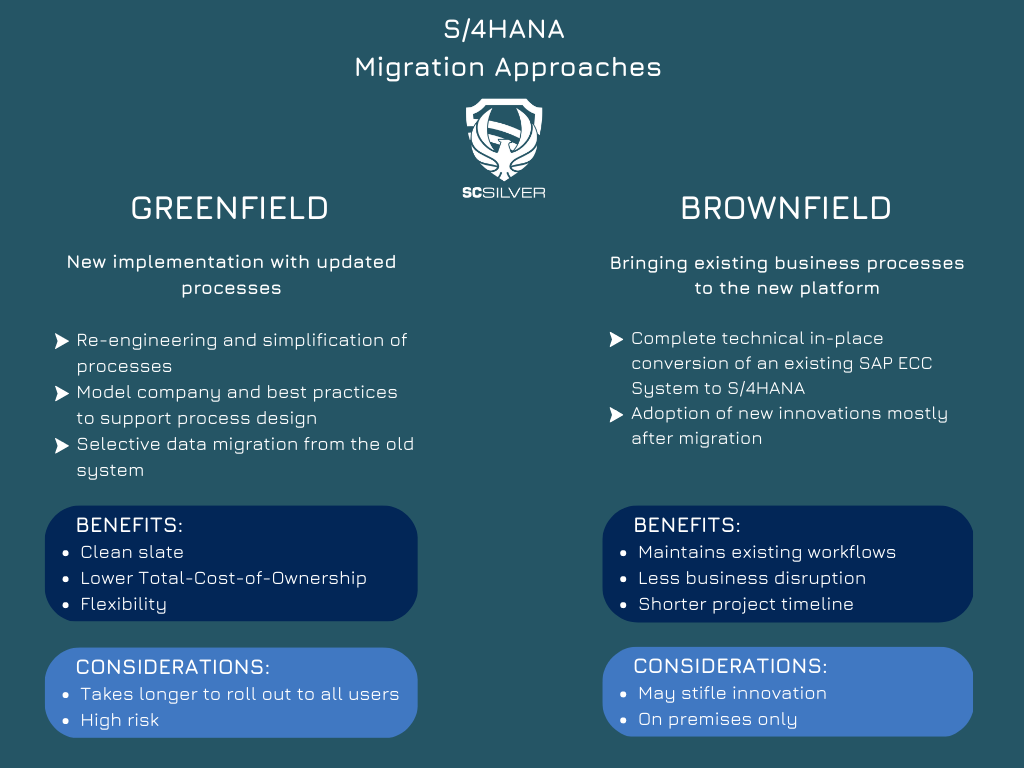
Introduction – S/4 HANA Transformation Journey
As companies aim to modernize and transform their operations, many are turning towards the latest generation of enterprise resource planning (ERP) software, SAP S/4 HANA. This advanced software, which succeeds SAP ECC (Enterprise Central Component), boasts numerous enhancements over prior versions of SAP software, including speedier data processing and analysis, simplified data models and user interface, advanced analytics and machine learning, and support for the Internet of Things. Nevertheless, upgrading from SAP ECC to S/4 HANA can be challenging and necessitates careful planning and execution, taking into account success factors, legacy systems, and process optimization. In this SC Silver blog post, we delve into the history of SAP software, the differences between S/4 HANA and previous versions, and the benefits and considerations of S/4 HANA transformation, including technology integration and the optimization of processes.
History – S/4 HANA Transformation and Legacy Systems
SAP software has a long history dating back to the 1970s with the release of SAP R/2, a mainframe-based software that was designed for large enterprises and focused on financial and logistics functions. In the 1980s, SAP released R/3, which was a client-server based software that expanded on the capabilities of R/2 and added support for more industries and business functions. R/3 was the flagship product of SAP for over two decades and became the most widely used enterprise resource planning (ERP) software in the world.
In the early 2000s, SAP released ECC (Enterprise Central Component), an evolution of the previous SAP R/3 that added support for new technologies such as the Internet and mobile devices. SAP ECC was also designed to be more modular, making it easier to customise and integrate with other systems.
In 2015, SAP released S/4 HANA as the successor to SAP ECC. S/4 HANA is a new generation of ERP software designed to run on the HANA database, a high-performance in-memory database technology. This new technology allows large volumes of data to be processed and analysed in real time, enabling businesses to make faster and more informed decisions. S/4 HANA also has a simplified data model and user interface, making it easier to use and customise.
It is important not to confuse S/4 HANA with the actual HANA database. One of the key differences between S/4 HANA and the HANA database is that S/4 HANA is a complete ERP system, while HANA is only the database. The S/4 HANA platform includes all the functionality and modules of the previous ECC ERP system, such as financials, logistics and human resources, as well as new capabilities such as advanced analytics, machine learning and the Internet of Things.
SAP has announced that support for ECC will end in 2027, and companies are encouraged to start planning their S/4 HANA transformation as soon as possible to take advantage of the new software and avoid disruptions to their business. The digital transformation process can be complex and requires careful planning and execution, but it can also be an opportunity for companies to modernise and transform their operations.

S/4 HANA Overview
SAP S/4 HANA is the latest generation of SAP’s enterprise resource planning (ERP) software and the successor to ECC (Enterprise Central Component). It offers significant improvements over previous versions of SAP software, such as faster data processing and analysis, simplified data models and user interface, advanced analytics and machine learning capabilities, and support for the Internet of Things.
S/4 HANA is available in three different versions: On-Premise, Cloud and Hybrid. On-Premise version is installed on customer’s own infrastructure, Cloud version is a subscription-based service hosted on the cloud, and Hybrid version is a combination of both On-Premise and Cloud versions. This allows customers to choose the deployment option that best suits their business needs and IT strategy.
One of the key technical differences between S/4 HANA and previous versions of SAP software is that it runs on the HANA database. HANA is an in-memory database technology that enables large volumes of data to be processed and analysed in real time. This enables organizations to make faster and more informed decisions. However, S/4 HANA no longer supports non-SAP databases, so customers will need to migrate their existing data to HANA in order to use S/4 HANA and continue the S/4 HANA transformation.
Key Considerations & Benefits for S/4 HANA Transformation
When considering a migration from SAP ECC to the new S/4 HANA, organisations often have a number of concerns and considerations. Some of the most common concerns include the cost and complexity of the business transformation process, the risk of business disruption, and the potential loss of customisations and integrations. In addition, some organisations may be reluctant to move to a new software platform that is relatively new and untested.
Despite these concerns, case studies have demonstrated that there are several benefits that organisations can gain by S/4 HANA transformation. One of the most important benefits is the improved performance and scalability of the HANA database, which allows large volumes of data to be processed and analysed in real time. This can lead to faster and more informed decision making, which can ultimately drive business growth and success.
Another key benefit of S/4 HANA is its simplified data model and user interface, making it easier to use and customise. This can help organisations streamline their operations and reduce the time and costs associated with maintaining and updating the software. In addition, S/4 HANA includes advanced analytics and machine learning capabilities that can provide valuable insights and enable organisations to make better use of their data.
In summary, while migrating from ECC to S/4 HANA may seem daunting, the benefits of real-time data processing, simplified data model, advanced analytics and machine learning capabilities make it a step forward for organisations to improve their operations and gain a competitive edge in the marketplace.
Preparing for the S/4 HANA Transformation Process
Migrating from SAP ECC to S/4 HANA involves a number of steps that can vary depending on the specific requirements and constraints of the organisation.
One of the first steps in the migration process is to assess the current state of the ECC system, including its customisations, integrations and data. This will help to identify any potential challenges or risks that may need to be addressed during the S/4 HANA transformation.
Once the assessment is complete, organizations can choose from different migration methods such as Greenfield, Brownfield and System Landscape Transformation. Greenfield migration is a new implementation of S/4 HANA without the use of any previous data or customizations. Brownfield migration is a more complex approach that involves migrating existing data and customizations from ECC to S/4 HANA. System Landscape Transformation is a semi-automated approach that allows to migrate the existing data, customisations and system landscape from ECC to S/4 HANA.

Next, organisations will need to plan and execute the actual migration. This can include a range of activities, such as data migration, system configuration, extensive testing, and training. It’s important to have a well-defined project plan, and a dedicated team with the skills and expertise to carry out the transformation.
Finally, organisations will need to validate the migration and perform post-migration activities such as testing, system stabilization and end user training.
It’s important to note that the transformation process can be complex and requires careful planning and execution, but with the right approach, organisations can successfully migrate to S/4 HANA and reap the benefits.
S/4 HANA by the Numbers
SAP has reported a steady growth in the adoption of their product S/4 HANA over the past few years. During the last quarter of 2022, SAP had approximately 20,000 customers using S/4 HANA.
It’s important to note that these 20,000 customers may not necessarily be new customers, as some may have switched from the previous software, ECC, which had around 35,000 customers at the time of S/4 HANA’s launch. Nevertheless, SAP claims that 60% of the 20,000 customers are newly acquired and not part of the original ECC customer base.
However, the picture becomes even more complex as some customers may have been required to obtain a license for S/4 HANA as a result of a settlement for previous issues, and the exact number of licenses included in package or contract deals is not specified.
A research firm, Gartner, conducted a study on the adoption of S/4 HANA and found that while 60% of customers who hold a license for S/4 HANA have initiated their migration or are live on the system, only 11% of the original 35,000 ECC customers have fully replaced their ECC system with S/4 HANA.
Although SAP reports a significant increase in the adoption of S/4 HANA, it’s crucial to understand that the numbers are not as straightforward as they may seem and require further examination to fully comprehend.
Companies that have yet to make the switch to S/4 HANA should take this opportunity to prepare their transition journey in advance, taking into account all relevant considerations. The S/4 HANA transformation is not just a technology upgrade but a transformation of the entire ERP system. With proper planning and preparation, companies can ensure a successful transition, reap the benefits offered by S/4 HANA and achieve a positive Return on Investment (ROI).
Conclusion – Realizing digital transformation with S/4 HANA
SAP launched its latest flagship product, S/4 HANA, in 2015 and announced that the support for ECC will end in 2027. While the company claims that more than 50% of customers have adopted the new software, the reality is that only a small percentage, likely around 10%, have fully migrated to the platform. For those who have yet to make the move, the process of S/4 HANA transformation can be complex and challenging.
To ensure a smooth transition and prevent any disruptions to business operations, it is recommended to initiate the migration process as soon as possible with a well-defined roadmap to tackle the challenges ahead. If you are interested in gaining more insight into how SC Silver Consultancy’s services can help you manage the complexities and mitigate the risks associated with your S/4 HANA migration, please feel free to contact our SAP experts.






